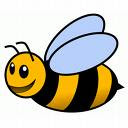
Wednesday, 19 November 2008
Thursday, 13 November 2008
Bee informed
Recently, managed populations of european honey bees have suffered substantial declines. We think this is in part caused by global warming, affecting the seasons and the time at which flowers bloom. Please help our research by posting your comments.
Even better - help your bees by visiting our shop and buying nests or seeds to improve their habitat!!! Half our profits go directly to Shropshire Wildlife Trust to help wildlife throughout Shropshire.

Here's a neat video of the bee life cycle (honey bee, not the solitary bees, but very similar...)
Bee supplied


Two of our bee nest boxes on a sheltered wall
---------------------------------------------------------------
The Red Mason Bee is friendly. The female is not very aggressive so you can go close to her and she only stings if she is handled roughly and the male bee does not even have a sting!


Red Mason Bee and two nesting tubes filled from last year
When she nests in a tube, about 8-10 cells with an egg can fit in a tube. A female will fill about 4-5 tubes in her life time. She puts lots of pollen with each egg for food. Put the nest boxes to face southerly so that the bees can warm up before going to fetch food when they hatch. It also needs to be near a muddy place so the bee can get mud to put in the tube to make walls, and not in bright sun so it doesnt warm up too much in winter. They need to be out of the rain or they might go mouldy.
Under the eves of a shed is an ideal place, providing shade from the midday sun.

Our Red Mason Bee nest boxes each contain about 30 tubes in a square container that is easy to put on a convenient ledge or nook. If you wish to put it on a wall we can also sell a wall mount bracket.
Red Mason bee nest box £7.99
---------------------------------------------------------------
Blue Mason Bee
The Blue Mason Bee, Osmia coerulescens is an excellent pollinator of garden herbs and visits a wide range of garden flowers. It is smaller than the Red Mason Bee and makes its appearance slightly later and continues nesting until the end of July/early August. It prefers the slightly smaller diameter tubes of our Blue Mason Bee nest box which contains up to 40 of these smaller tubes.
Each of our nest boxes will help your gardens bee population, and the two different boxes will complement each other and encourage both bees to prolong your pollination season.
Blue Mason and Leaf-cutter bee nest box £7.99
---------------------------------------------
If you don't have any convenient ledges, the bee nest can be wall mounted to a shed or garage wall with our mounting bracket
Bee nest mounting bracket £1.99
------------------------------------------------------------
Another way to encourage bees and other useful insects is to grow your own wild flower meadow. These native species provide an excellent natural english habitat and create an attractive 'wild' corner in your garden. Each packet contains sufficient seed for 5 square metres
Meadow seed annual mix £1.99






